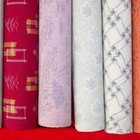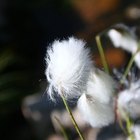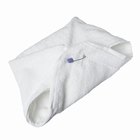Fleece and microfleece are soft and comfortable fabric options for clothing and accessories. They are both extremely lightweight and are resilient enough for everyday use as well as for high performance gear (such as clothing for mountain climbing). They are often used to line outerwear or used as the primary fabric when added warmth is needed. Fleece and microfleece are also used for casual wear clothing, such as sweaters, gym clothing and light outdoor jackets. Fleece and microfleece are also used to make lightweight and inexpensive throw blankets.
Differences
Fleece and microfleece are often used as interchangeable terms. They are also both often referred to as polar fleece. However, fleece is the general term for all thicknesses of fleece, whereas microfleece refers specifically to the thinnest and most flexible of all the fleece thicknesses. After microfleece, the other thicknesses include 100, 200 and 300 thread count.
Material
Both fleece and microfleece are synthetic products. It is often compared to a soft wool, although it is not made from a natural fiber and generally weighs much less than wool garments or products. Generally, both fleeces are made from polyester. As well, fleeces can be "vegan" because they can be manufactured entirely from recycled plastic materials---usually plastic bottles.
Care
Both materials do not hold liquid very well and are highly breathable. Because of these attributes, both fleece and microfleece are easy to wash and take care of because perspiration or spilt liquids pass easily through the fabric.
Benefits and Disadvantages
Fleece is an easy way to add lightweight warmth, either as a liner or as an extra layer of clothing. Fleece is usually considered more environmentally friendly when it is made from recycled materials. However, "regular" fleece that is not made from recycled materials is often made from petroleum, which is not environmentally friendly. As well, fleece is more flammable than wool, and outdoor clothing should generally be treated with a flame retardant. Last, fleece is very breathable, which makes it a useful choice for fitness and outdoor activities, however, it is not wind or waterproof.
Related Articles

Microfiber vs. Cotton Clothes

Thinsulate Vs. Thermolite

Differences Between Polyester and Nylon ...

What Is the Difference Between Acrylic ...

Fabrics Similar in Weight to Taffeta

What Is the Difference Between Lycra ...

The Advantages & Disadvantages of Woven ...

The Differences of Neoprene & Thinsulate

Define Cotton Silk Fabric

Cordura Vs. Kevlar

What Is Berber Fleece?

The Difference Between Polartec and ...

Microfleece Vs. Microplush

1,000 Denier Cordura Specifications

What Season to Wear Corduroys?

Sheepskin Vs. Deerskin

Natural Vs. Synthetic Clothing

Rayon Spandex Care Instructions

What Are the Advantages & Disadvantages ...

Properties of Cotton Fabric
References
Writer Bio
Based in Toronto, Ontario, Charlie Johnson began writing professionally about music and food in 2006. She has worked in the food service industry since 2003 and has been a professional musician since 1998. She writes about music, food, cooking, education and travel. Johnson holds a Bachelor of Music degree from McGill University.